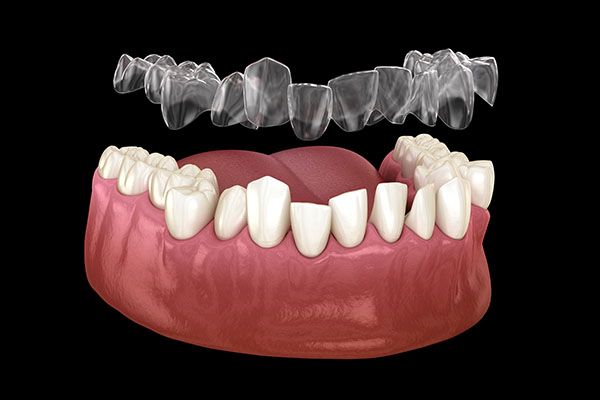 You probably have heard of Invisalign® but might not know how it differs from traditional braces when it comes to teeth straightening. Braces have been the go-to teeth-straightening device for many years. More recently, Invisalign has gained popularity in patients with crowding or spacing issues. Because it looks so different from traditional braces, you may have a lot of questions about whether Invisalign is right for you.
You probably have heard of Invisalign® but might not know how it differs from traditional braces when it comes to teeth straightening. Braces have been the go-to teeth-straightening device for many years. More recently, Invisalign has gained popularity in patients with crowding or spacing issues. Because it looks so different from traditional braces, you may have a lot of questions about whether Invisalign is right for you.
How does Invisalign work?
Unlike braces, Invisalign is removable. Dentists digitally map the teeth to create personalized plastic trays. These trays slowly move the teeth into alignment. As the patient progresses and the teeth move, the trays change. The dentist will work with the patient to create the new trays. Patients who follow instructions and wear the trays as the dentist prescribes will see the most success.
How long will I need Invisalign?
Every patient’s mouth is different. Dentists work with the patient to determine how much the teeth need to move. Most patients will wear their Invisalign trays for at least a year. It can take longer if the patient does not follow instructions for wear. Some patients have teeth that are significantly out of place. Those people may need to wear the trays longer.
What is the difference between Invisalign and braces?
Traditional braces and Invisalign produce similar results but in very different ways. Metal braces are highly visible. Braces attach to the front of the teeth and use wires and brackets to move the teeth into place. Patients often need to wear braces for two to three years and, in some cases, longer. Unlike Invisalign, patients cannot remove traditional braces to eat or perform oral hygiene.
Some people like being able to remove the Invisalign trays, but others worry about misplacing or even throwing away the customized trays. Another difference is how patients eat. Patients with braces must avoid very sticky and hard foods. Invisalign users remove the trays to eat and reinsert them after cleaning their teeth. If a patient does not clean their teeth before reinserting the Invisalign trays, there is a risk of developing tooth decay. Many patients appreciate not having to avoid eating certain foods with Invisalign.
Is Invisalign the right choice?
Invisalign will not make teeth erupt from the gums. Some patients with extreme misalignment may not be able to use Invisalign right away. Patients who do not wear the Invisalign trays enough will have slower progress. Some patients feel a little discomfort because the trays are gently pushing the teeth into position. Patients who already have bridgework or crowns may not be able to use Invisalign since the trays move teeth individually.
The FDA has approved the high-grade plastic as biocompatible. Your dentist will assess you to determine if Invisalign is a good choice. Many people can choose Invisalign for teeth straightening with great success. Most offices will also work with you to develop a financing or payment plan if your insurance does not cover Invisalign. Invisalign can be a great choice for both adults and teens.
Request an appointment or call Visalia Care Dental at 559-975-1213 for an appointment in our Visalia office.
Related Posts
You may know that Invisalign® is different than traditional braces, but you may not know all the reasons why. Both Invisalign and traditional braces straighten your teeth and correct other issues, but in very different ways. For many, Invisalign aligners are a great choice to straighten the teeth without visible brackets and wires. There are…
In recent years, Invisalign® has become increasingly popular to straighten misaligned teeth. There are many benefits of this type of orthodontic treatment over traditional braces. Patients can remove the aligners to brush and floss the teeth, making oral hygiene measures much easier. Treatment time is often shorter, and the clear trays are not as noticeable…
Invisalign® and braces are very different tools that can give patients an even smile with straightened teeth. Because patients must wear teeth alignment devices for a while, you might wonder if you will need repairs to your device. Patients often wonder if one type of device needs more repairing than another. For most patients, one…
